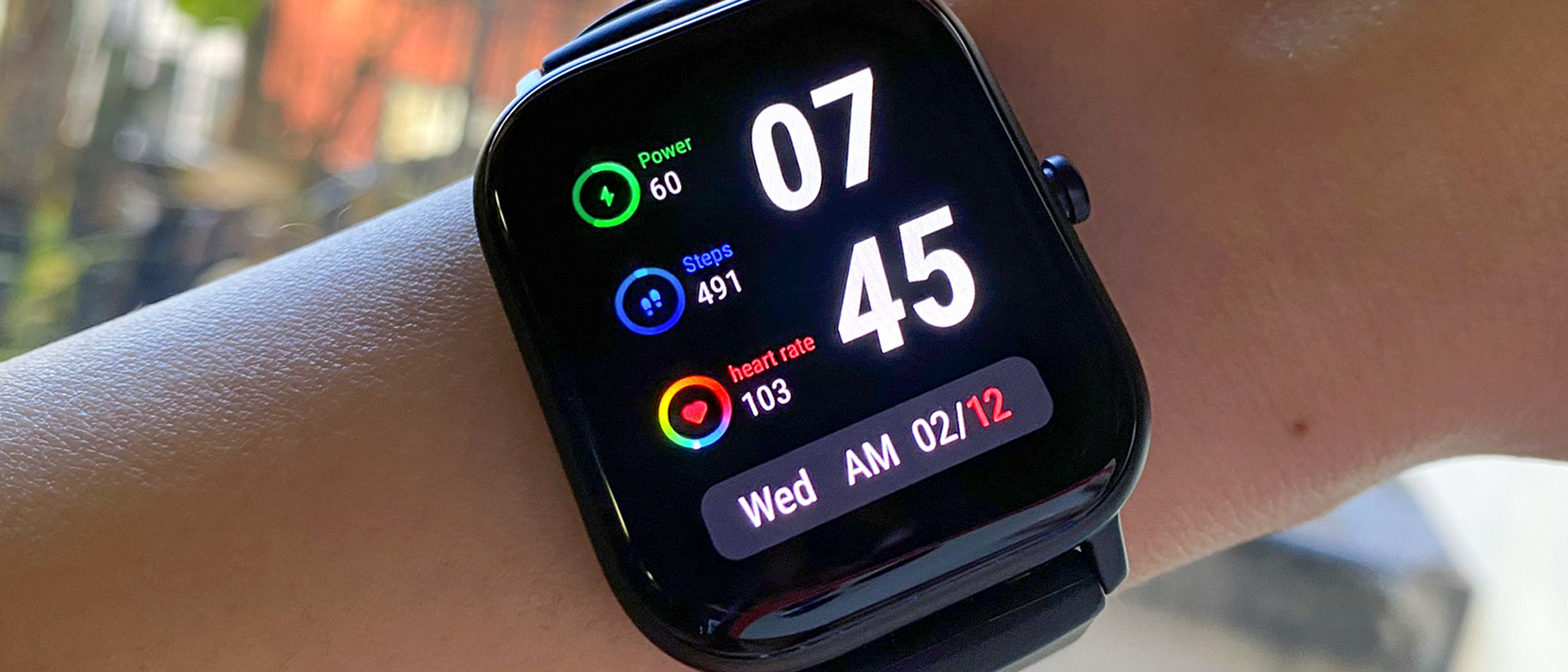Tom's Guide Verdict
The Amazfit GTS looks great and is relatively cheap, but its fitness tracking could be better.
Pros
- +
Excellent battery life
- +
Comfortable for 24/7 wear
- +
Great display
- +
Quality design
Cons
- -
Can't respond to notifications
- -
Inaccurate step counting and sleep tracking
- -
Doesn't integrate with many third-party apps or devices
- -
High price for the functionality
Why you can trust Tom's Guide
Huami's premium GPS fitness tracker, the Amazfit GTS, looks like it costs quite a bit more than its $150 price tag. Mostly because it looks a heck of a lot like the Apple Watch.
Size: 1.7 x 1.4 x 0.4 inches
Weight: 0.8 ounces
Screen size/resolution: 1.65-inch AMOLED/442 x 348 pixels
Smartwatch compatibility: Android/iPhone
Water resistance: 50 meters
GPS: Yes
Heart rate monitor: Yes
Battery life: 14 days/25 hours with GPS
Case size: 42 mm
Watch band size: 20 mm
Seriously — while I was testing the Amazfit GTS, I dropped by an Apple Store in Beverly Hills, California, to pick up a new iPhone, and more than one employee (at the Apple Watch display, no less) thought I was wearing an Apple Watch. I don't blame them; at first glance, the Amazfit GTS looks almost exactly like the Apple Watch Series 5, right down to the ultra similar dimensions.
If your main reason for buying a fitness tracker is to fool Apple Store employees, this is the device for you. As you'll see in our Amazfit GTS review, it has more to offer than just a copycat aesthetic: The GTS not only looks high end but also feels high end — the case is well-built and sturdy, and the strap is ultracomfortable to wear.
It also has built-in GPS, a heart rate sensor with continuous heart rate monitoring, and a battery that lasts at least a week and a half before it needs to be charged. However, it has a few issues that keep it from being one of the best fitness trackers.
Amazfit GTS: Design
The Amazfit GTS isn't even trying for originality; the design philosophy is Apple Watch. There are a handful of differences between the two, but they're pretty subtle. The GTS has slightly rounder corners, a smaller, centered crown and lugs built into the case. It's marginally smaller and thinner, and quite a bit lighter (0.8 ounces versus 1.3 ounces) than Apple's wearable. This is good; the Apple Watch comes in two sizes, but the Amazfit GTS only comes in one size, which is a little too big for someone with abnormally small wrists like mine. The sleeker, lighter profile makes the 42-millimeter GTS less overwhelming than the 44-mm Apple Watch.
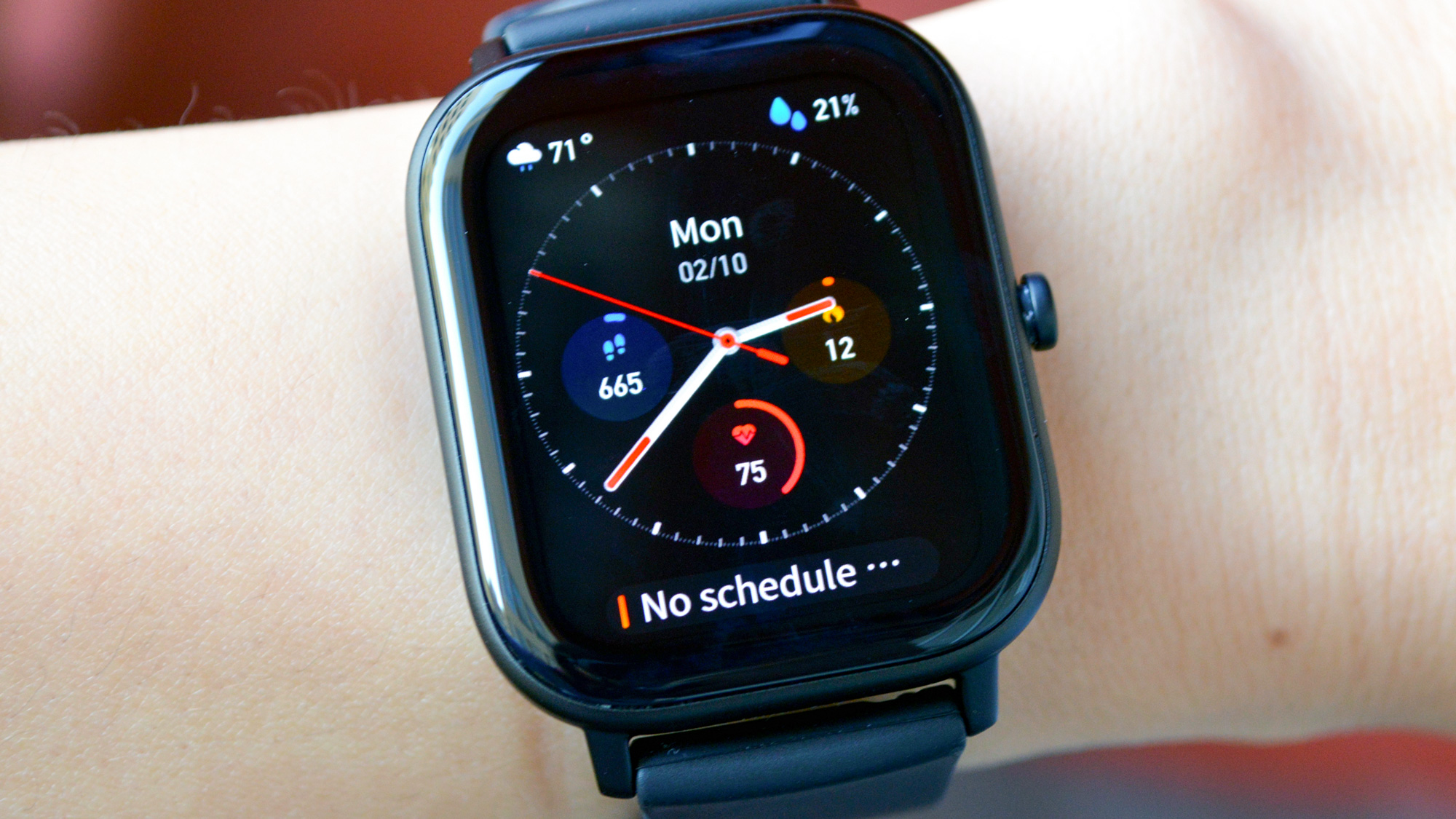
The GTS has a fabulously pretty glass display: A 1.65-inch AMOLED screen with a resolution of 442 x 348 pixels, or 341 pixels per inch (ppi). By comparison, the 44-mm Apple Watch Series 5 has a 1.78-inch OLED screen with a resolution of 448 x 368 pixels, or 326 ppi. In other words, the GTS' screen easily holds its own against the Apple Watch's — it's crisp, clear, bright, easy to read in direct sunlight and easily navigable with swipes and taps. The GTS' "crown" is a multifunction button you can use to wake the device and back out of menus. (It also spins, but spinning it has no function.)
The GTS comes in six color combos: Matte black with a black strap, matte gray with a gray strap, polished gold with a tan strap, matte silver with an orange strap, matte pink with a pink strap and matte blue with a blue strap. The included strap is made of silicone and is surprisingly comfortable, but it does look kind of cheap with the GTS' premium watch case. The strap is attached to the case via quick-release spring bar pins, so it's easily swappable. Amazfit doesn't sell official accessories, but there are plenty of third-party options; you can also use a regular 20-mm watch band.
Get instant access to breaking news, the hottest reviews, great deals and helpful tips.
It's water-resistant up to 50 meters, so it should be safe for swimming laps, but Huami advises against wearing it while diving into water or taking hot showers.
Amazfit GTS: Features
The Amazfit GTS may look like a high-end smartwatch, but it functions more like a souped-up fitness tracker. It offers some of the smartwatch features found in higher-end fitness trackers, such as app notifications, music control and an optional always-on display. The GTS runs Huami's proprietary operating system, which is fairly robust for a fitness tracker but limited for a smartwatch. You can use the GTS to control music, for example, but only if it's already playing on your phone. (You can't start a playlist from the watch.) And, while you can view notifications from your smartwatch, you can't reply to them.
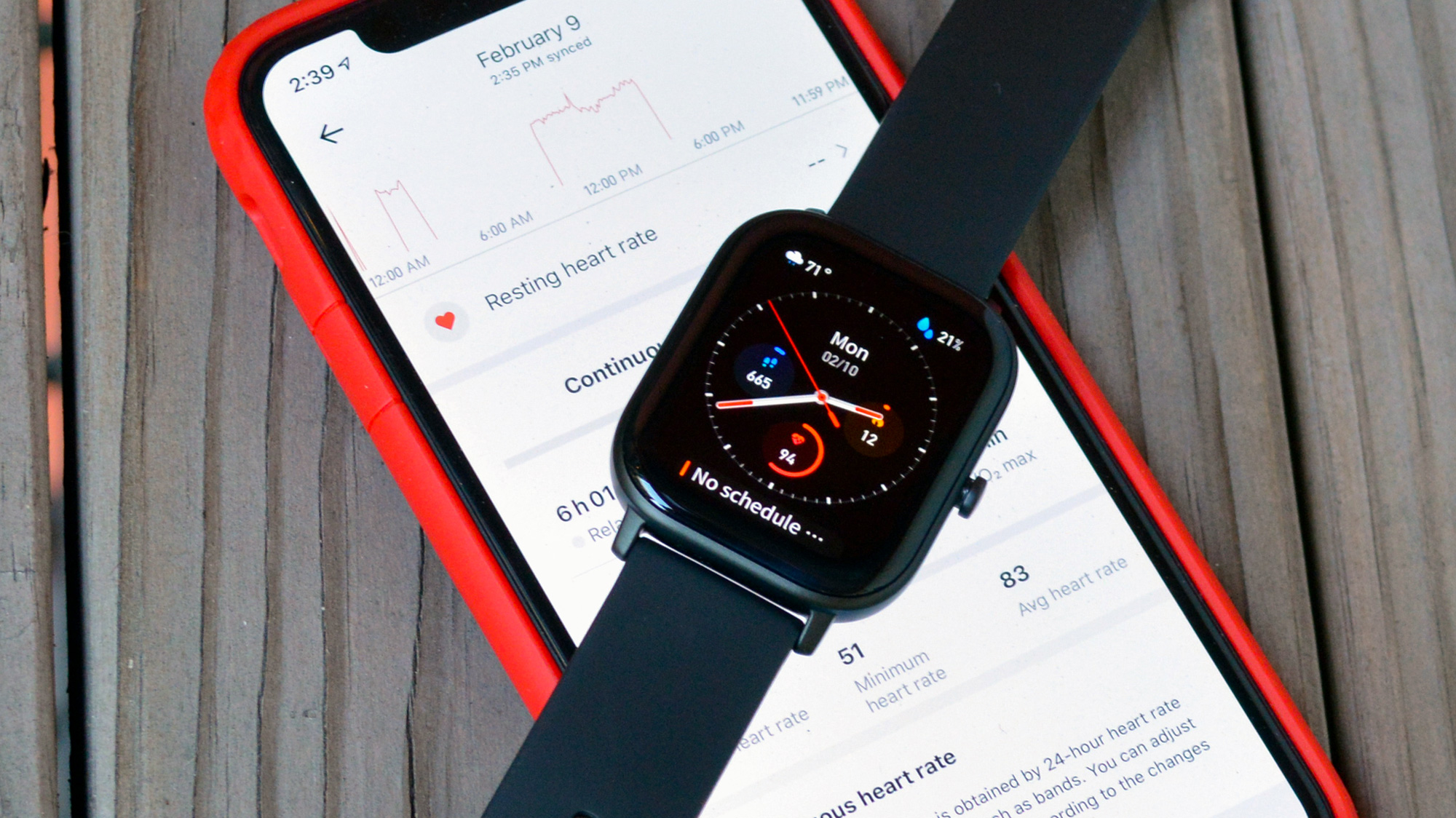
The Amazfit GTS works with the Amazfit app (available for Android and iOS), which can be a little confusing to navigate, partly because it overwhelms you with customizable options and multiple settings menus. (The device's onboard OS is much more intuitive.) The app is where you can see your activity history, track additional metrics, set up custom app notifications and download new watch faces.
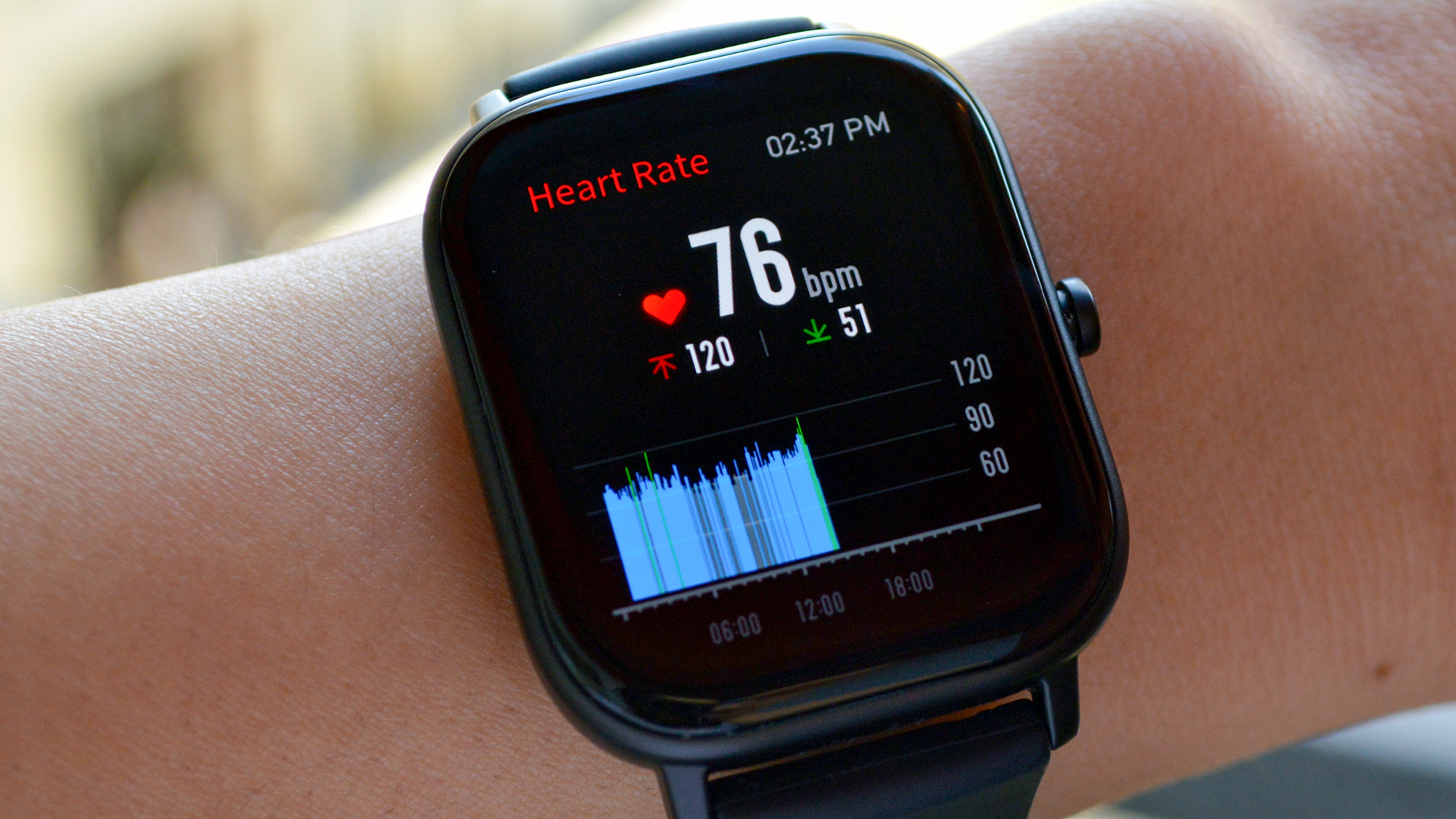
The Amazfit GTS has plenty of onboard tech for fitness tracking, including built-in GPS, a six-axis accelerometer, a three-axis geometric sensor and Huami's proprietary BioTracker optical heart rate sensor. The GTS automatically tracks steps, distance, calories burned, heart rate and Personal Activity Intelligence (PAI) score. PAI is a lifestyle "score" that measures your activity level while taking into account your individual stats (age, gender, resting heart rate and maximum heart rate) — it's harder for someone who's in good shape to get a high score versus someone who's never worked out before. Your PAI score is calculated over a rolling period of seven days, and keeping it above 100 may reduce your risk of cardiovascular disease.

It also has 12 manual workout modes — seven GPS activities (outdoor running, walking, outdoor cycling, open-water swimming, climbing, trail running and skiing) and five non-GPS activities (treadmill, indoor cycling, pool swimming, elliptical trainer and freestyle).
Amazfit GTS: Fitness and sleep tracking
I spent eight days wearing the Amazfit GTS, and I found its tracking accuracy to be somewhat inconsistent. My biggest issue was step counting; it wasn't wildly off base, but step counting is the most basic fitness-tracking metric. The GTS seemed to have difficulty tracking steps in small spaces (e.g., around my apartment) and when there was no forward motion (e.g., on a treadmill). The trek from my home office to my kitchen isn't a lot of steps, but it's also not zero steps, which is what the GTS recorded multiple times. (Other trackers, such as the Garmin Vivoactive 3, had no problem logging those 45 steps.)

The GTS also had trouble with sleep tracking. It only recorded two of my sleep sessions in eight days — the two where I fell asleep during "night" hours. Now, I'll admit that I'm an outlier when it comes to sleeping, because I have an unusual and inconsistent sleep schedule (for what it's worth, this is why I'm particularly sensitive to sleep tracking inaccuracies), but limiting sleep to nighttime hours seems like an arbitrary, unnecessary restriction.
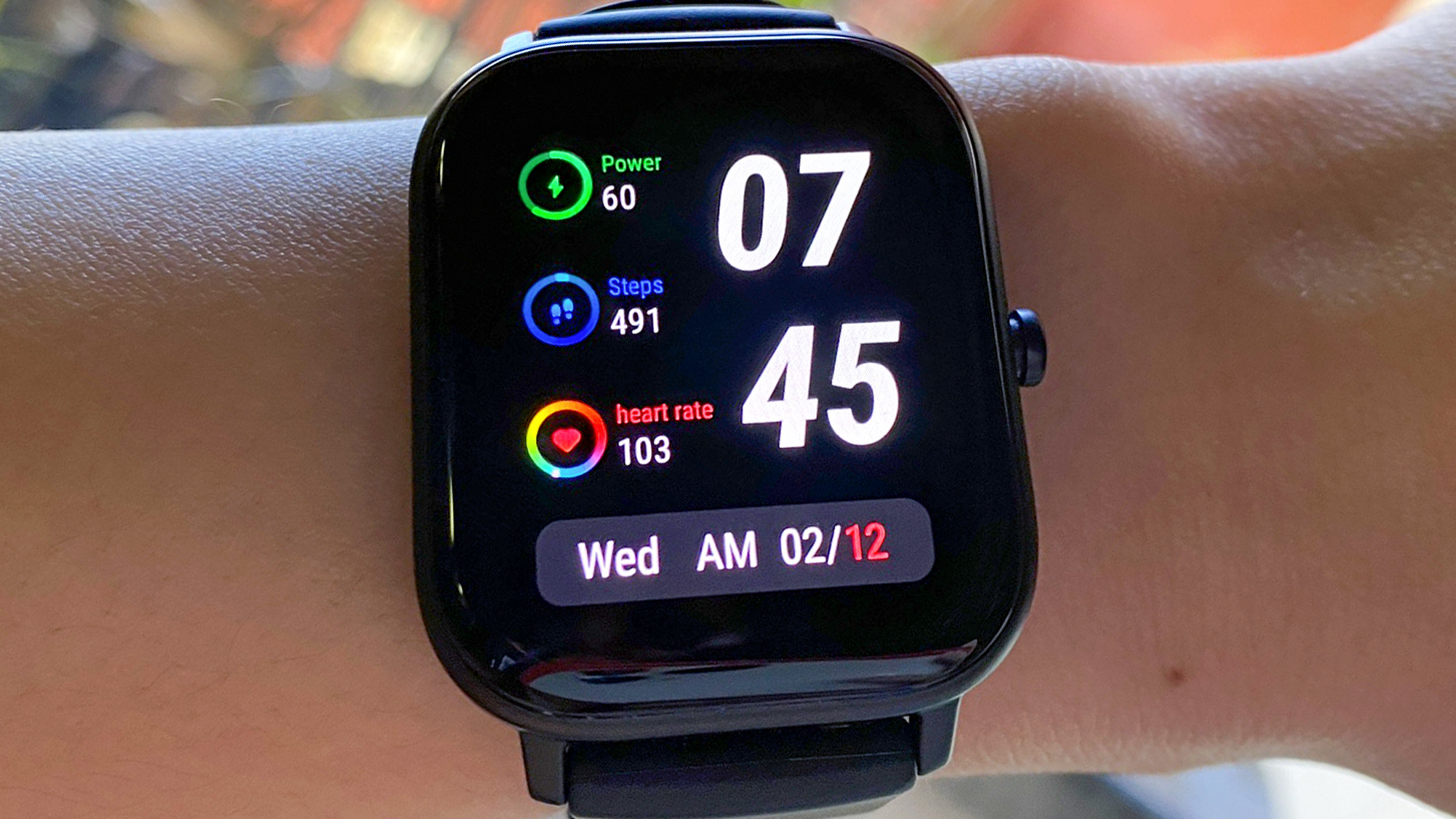
The GTS did do a good job tracking some metrics — I particularly liked the continuous heart rate monitoring (which does put a large strain on battery life). The heart rate monitor was a little jumpy at times, but the overall picture from all the data points throughout the day was pretty accurate. The GTS also did an excellent job of tracking activities that used GPS, both with and without my phone. It was even able to pretty accurately track the exact corners my dog stopped at while we were walking.
Amazfit GTS: Battery life
Battery life always seems to be a win with Huami devices, and the Amazfit GTS doesn't disappoint. After eight days of higher-than-average usage, my GTS still had about 25 percent battery life. It will probably last only another two or three days. While that's not quite the company's 14-day estimate, it's definitely above average for a GPS tracker with app notifications and regular heart rate monitoring.
Amazfit GTS: Verdict
There's a lot that I love about the Amazfit GTS. It looks great — even if you're not an Apple Watch fan, it's sleek, well-built and has an overall premium look. It's shockingly comfortable and comes in a lot of pretty colors, and it has built-in GPS and above-average battery life. And, at $150, it's relatively inexpensive.
But it's definitely more fitness tracker than smartwatch, and I won't lie — I'm wary of a fitness tracker that has trouble consistently tracking something as basic as step count. The GTS also runs a proprietary OS and doesn't integrate with many third-party apps. That wouldn't be as much of a problem if it wasn't competing against companies like Garmin and Fitbit, which have robust ecosystems, intuitive apps and products in the same price range. Check out our Garmin Vivoactive 3 review example, which costs the same as the Amazfit GTS, yet offers more features, such as mobile payments and better workout tracking.
If you're looking for one of the best cheap smartwatches, look no further than the Amazfit Bip, which isn't as sleek but is half as much and has very similar functionality. The Amazfit GTS looks really, really good, but that's what you're paying for.
Sarah is a hardware enthusiast and geeky dilettante who has been building computers since she discovered it was easier to move them across the world — she grew up in Tokyo — if they were in pieces. She's currently senior editor at our sister site Tom's Hardware and is best-known for trying to justify ridiculous multi-monitor setups, dramatically lowering the temperature of her entire apartment to cool overheating components, typing just to hear the sound of her keyboard, and playing video games all day "for work." She's written about everything from tech to fitness to sex and relationships, and you can find more of her work in PCWorld, Macworld, TechHive, CNET, Gizmodo, PC Gamer, Men's Health, Men's Fitness, SHAPE, Cosmopolitan, and just about everywhere else. In addition to hardware, she also loves working out, public libraries, marine biology, word games, and salads. Her favorite Star Wars character is a toss-up between the Sarlacc and Jabba the Hutt.
